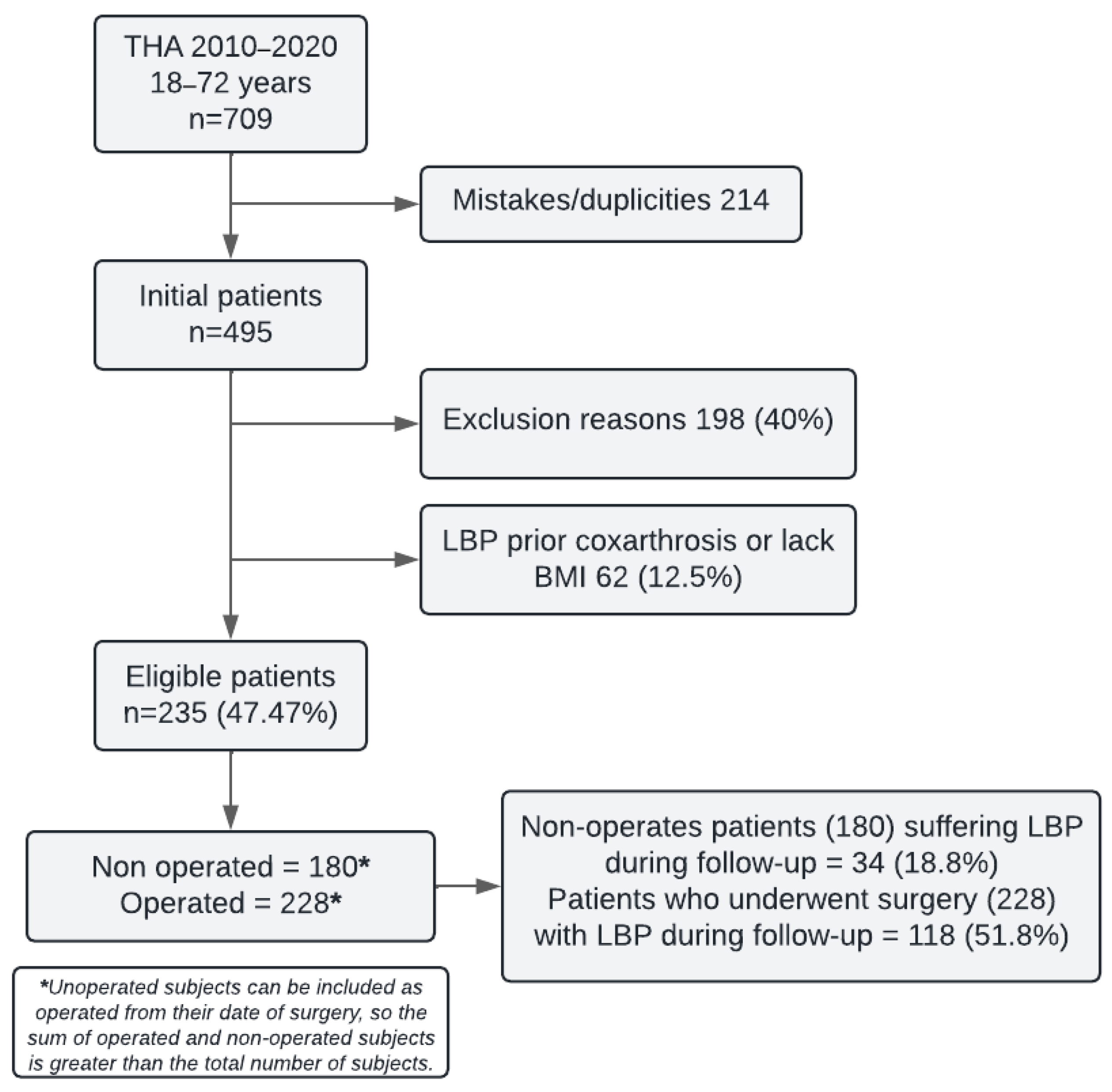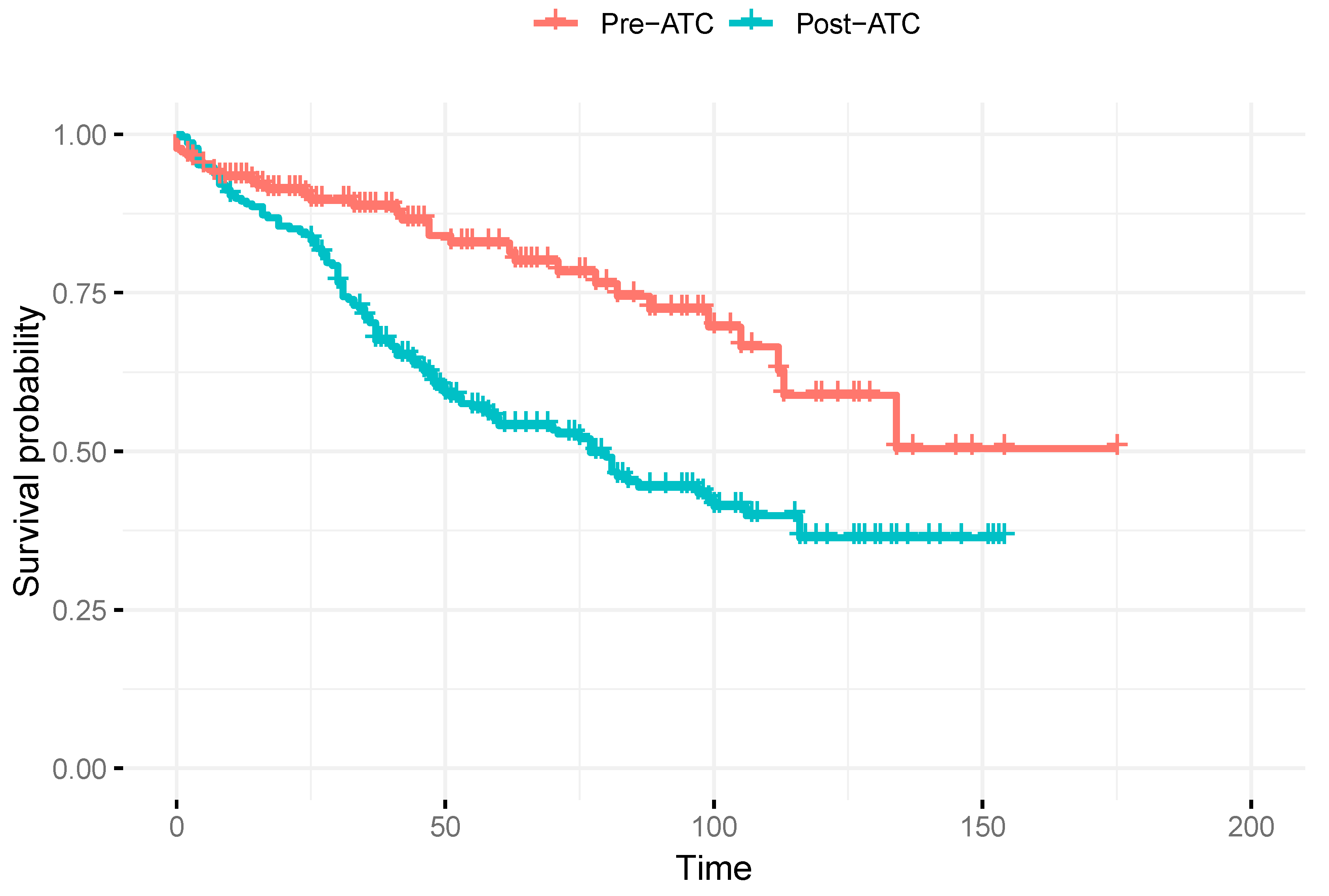Cohort-Based Evaluation of the Risk of Low Back Pain After Total Hip Arthroplasty: A Long-Term Study
Abstract
1. Introduction
2. Materials and Methods
2.1. Study Design
2.2. Participants and Follow-Up
2.3. Variables and Data Sources
2.4. Data Analysis
2.5. Sensitivity Analysis
2.6. Ethical Aspects
3. Results
3.1. Baseline Characteristics and Initial Follow-Up Period
3.2. Survival Function and HR of LBP During 5 Years of Follow-Up
3.3. Sensitivity Analysis Outcomes
4. Discussion
5. Conclusions
Author Contributions
Funding
Institutional Review Board Statement
Informed Consent Statement
Data Availability Statement
Acknowledgments
Conflicts of Interest
Abbreviations
| HOA | Hip osteoarthritis |
| THA | Total hip arthroplasty |
| LBP | Low back pain |
| BMI | Body mass index |
| HR | Hazard ratio |
References
- Dagenais, S.; Garbedian, S.; Wai, E.K. Systematic Review of the Prevalence of Radiographic Primary Hip Osteoarthritis. Clin. Orthop. Relat. Res. 2009, 467, 623–637. [Google Scholar] [CrossRef] [PubMed]
- Lo, J.; Chan, L.; Flynn, S. A Systematic Review of the Incidence, Prevalence, Costs, and Activity and Work Limitations of Amputation, Osteoarthritis, Rheumatoid Arthritis, Back Pain, Multiple Sclerosis, Spinal Cord Injury, Stroke, and Traumatic Brain Injury in the United States: A 2019 Update. Arch. Phys. Med. Rehabil. 2021, 102, 115–131. [Google Scholar] [CrossRef] [PubMed]
- Fan, Z.; Yan, L.; Liu, H.; Li, X.; Fan, K.; Liu, Q.; Li, J.J.; Wang, B. The prevalence of hip osteoarthritis: A systematic review and meta-analysis. Arthritis Res. Ther. 2023, 25, 51. [Google Scholar] [CrossRef]
- Hoaglund, F.T.; Steinbach, L.S. Primary Osteoarthritis of the Hip: Etiology and Epidemiology. J. Am. Acad. Orthop. Surg. 2001, 9, 320–327. [Google Scholar] [CrossRef] [PubMed]
- Skousgaard, S.G.; Hjelmborg, J.; Skytthe, A.; Brandt, L.P.A.; Möller, S.; Overgaard, S. Probability and heritability estimates on primary osteoarthritis of the hip leading to total hip arthroplasty: A nationwide population based follow-up study in Danish twins. Arthritis Res. Ther. 2015, 17, 336. [Google Scholar] [CrossRef]
- Bassamat, O.; Ahmed, D.N.; Emhms, A.B.D.; El-Naby, D.N. Discharge Needs of Patients after Total Hip Arthroplasty. Med. J. Cairo Univ. 2018, 86, 179–185. [Google Scholar] [CrossRef]
- Zhang, B.; Rao, S.; Mekkawy, K.L.; Rahman, R.; Sarfraz, A.; Hollifield, L.; Runge, N.; Oni, J.K. Risk factors for pain after total hip arthroplasty: A systematic review. Arthroplasty 2023, 5, 19. [Google Scholar] [CrossRef] [PubMed]
- Parvizi, J.; Pour, A.E.; Hillibrand, A.; Goldberg, G.; Sharkey, P.F.; Rothman, R.H. Back Pain and Total Hip Arthroplasty: A Prospective Natural History Study. Clin. Orthop. Relat. Res. 2010, 468, 1325–1330. [Google Scholar] [CrossRef] [PubMed]
- Karvetti, R.L.; Knuts, L.R. A prospective study of low back pain in a general population. I. Occurrence, recurrence and aetiology. J. Rehabil. Med. 1983, 15, 71–79. [Google Scholar] [CrossRef]
- Potaczek, T.; Jasiewicz, B. How back pain influences daily activities and quality of life: Incidence of back pain related to age. J. Child. Orthop. 2023, 17, 505–511. [Google Scholar] [CrossRef] [PubMed]
- Abdelbasset, W.K.; Sulieman, A. An Overview on Low Back Pain and Functional Disability: Associated Risk Factors and Management. J. Disabil. Res. 2022, 1, 19–22. [Google Scholar] [CrossRef]
- Ben-Galim, P.; Ben-Galim, T.; Rand, N.; Dekel, S.; Floman, Y. Hip-Spine Syndrome: The Effect of Total Hip Replacement Surgery Upon Low Back Pain in Patients with Severe Osteoarthritis of the Hip. Spine J. 2007, 32, 2099–2102. [Google Scholar] [CrossRef]
- Wang, W.; Sun, M.; Xu, Z.; Qiu, Y.; Weng, W. The low back pain in patients with hip osteoarthritis: Current knowledge on the diagnosis, mechanism and treatment outcome. Ann. Jt. 2016, 1, 9. [Google Scholar] [CrossRef]
- Vigdorchik, J.M.; Shafi, K.A.; Kolin, D.A.; Buckland, A.J.; Carroll, K.M.; Jerabek, S.A. Does Low Back Pain Improve Following Total Hip Arthroplasty? J. Arthroplast. 2022, 37, S937–S940. [Google Scholar] [CrossRef]
- Mak, D.; Chisholm, C.; Davies, A.M.; Botchu, R.; James, S.L. Psoas muscle atrophy following unilateral hip arthroplasty. Skelet. Radiol. 2020, 49, 1539–1545. [Google Scholar] [CrossRef] [PubMed]
- Oichi, T.; Taniguchi, Y.; Oshima, Y.; Tanaka, S.; Saito, T. Pathomechanism of intervertebral disc degeneration. JOR Spine 2020, 3, e1076. [Google Scholar] [CrossRef] [PubMed]
- Gallego-Peñalver, F.J.; Romero-De-La-Higuera, S.B.; Cía-Blasco, P.; Gómez-Trullén, E.M. Long-term survival analysis of low back pain onset in patients undergoing hip prosthesis surgery: A Kaplan–Meier study. Orthop. Traumatol. Surg. Res. 2024, 104149. [Google Scholar] [CrossRef]
- Hernán, M.A.; Robins, J.M. Using Big Data to Emulate a Target Trial When a Randomized Trial Is Not Available. Am. J. Epidemiol. 2016, 183, 758–764. [Google Scholar] [CrossRef] [PubMed]
- Gallego Peñalver, F.J.; Cía Blasco, P.; Gómez Trullén, E.M. Unilateral Psoas Muscle Atrophy as a Possible Risk Factor for Low Back Pain After Total Hip Arthroplasty: A Case Report. Jrehab 2025, 25, 4. Available online: http://rehabilitationj.uswr.ac.ir/article-1-3463-en.html (accessed on 1 February 2025).
- Eyvazov, K.; Eyvazov, B.; Basar, S.; Nasto, L.A.; Kanatli, U. Effects of total hip arthroplasty on spinal sagittal alignment and static balance: A prospective study on 28 patients. Eur. Spine J. 2016, 25, 3615–3621. [Google Scholar] [CrossRef] [PubMed]
- Gouveia, K.; Shah, A.; Kay, J.; Memon, M.; Simunovic, N.; Cakic, J.N.; Ranawat, A.S.; Ayeni, O.R. Iliopsoas Tenotomy During Hip Arthroscopy: A Systematic Review of Postoperative Outcomes. Am. J. Sports Med. 2021, 49, 817–829. [Google Scholar] [CrossRef]
- Genc, A.S.; Agar, A.; Güzel, N. Evaluation of Psoas Muscle Atrophy and the Degree of Fat Infiltration After Unilateral Hip Arthroplasty. Cureus 2023, 15, e41506. [Google Scholar] [CrossRef] [PubMed]
- Kutcher, S.A.; Brophy, J.M.; Banack, H.R.; Kaufman, J.S.; Samuel, M. Emulating a Randomised Controlled Trial With Observational Data: An Introduction to the Target Trial Framework. Can. J. Cardiol. 2021, 37, 1365–1377. [Google Scholar] [CrossRef] [PubMed]
- A Matthews, A.; Danaei, G.; Islam, N.; Kurth, T. Target trial emulation: Applying principles of randomised trials to observational studies. BMJ 2022, 378, e071108. [Google Scholar] [CrossRef] [PubMed]
- Matthews, A.A.; Young, J.C.; Kurth, T. The target trial framework in clinical epidemiology: Principles and applications. J. Clin. Epidemiol. 2023, 164, 112–115. [Google Scholar] [CrossRef] [PubMed]
- Rasch, A.; Byström, A.H.; Dalen, N.; Berg, H.E. Reduced muscle radiological density, cross-sectional area, and strength of major hip and knee muscles in 22 patients with hip osteoarthritis. Acta Orthop. 2007, 78, 505–510. [Google Scholar] [CrossRef] [PubMed]
- Rasch, A.; Byström, A.H.; Dalén, N.; Martinez-Carranza, N.; Berg, H.E. Persisting muscle atrophy two years after replacement of the hip. J. Bone Jt. Surg. Br. 2009, 91, 583–588. [Google Scholar] [CrossRef] [PubMed]
- Vasarhelyi, E.M.; Williams, H.A.; Howard, J.L.; Petis, S.; Barfett, J.; Lanting, B.A. The Effect of Total Hip Arthroplasty Surgical Technique on Postoperative Muscle Atrophy. Orthopedics 2020, 43, 361–366. [Google Scholar] [CrossRef] [PubMed]
- Di Monaco, M.; Vallero, F.; Tappero, R.; Cavanna, A. Rehabilitation after total hip arthroplasty: A systematic review of controlled trials on physical exercise programs. Eur. J. Phys. Rehabil. Med. 2009, 45, 303–317. [Google Scholar]


| Inclusion Criteria | |
| - Age 18–72 years at the time of intervention. - THA performed between 2010 and 2020. | |
| Absolute Exclusion Criteria | |
| - Previous lower limb or axial fracture - THA due to fractures. - Lower limb amputations. - Revision THA surgeries. - Inflammatory diseases. - Neurodegenerative diseases. - Mental illness. - Patients whose Electronic Medical Record only contains the surgical report. | - Avascular necrosis of the femoral head. - Legg–Calvé–Perthes disease. - Hip dysplasias. - Congenital skeletal abnormalities. - Vertebral surgery prior to THA. - Scoliosis. - Scheuermann’s disease. - Neoplasms affecting the axial skeleton. - Bone or prosthetic infections. |
| Partial Exclusion Criteria | |
| - Bilateral total hip prosthesis. - Chronic alcoholism. - Cervical surgery. | - Previous knee arthroscopy. - Posterior knee replacement. - Post-THA leg length discrepancy. |
| Other Exclusion Criteria | |
| - Insufficient data on covariates. - Presence of low back pain prior to a diagnosis of coxarthrosis. | |
| Characteristics | Pre-Surgery (n = 180) | Post-Surgery (n = 228) | SMD |
|---|---|---|---|
| Sex | 0.04 | ||
| Male | 115 (64%) | 141 (62%) | |
| Female | 65 (36%) | 87 (38%) | |
| Median age, in years (IQR) | 57 (52–63) | 61 (55–67) | 0.46 |
| BMI, in Kg/cm2 (IQR) | 29 (26–32) | 29 (26–32) | 0.01 |
| Median disease progression, in months (IQR) | 0 (0–0) | 25 (3–66) | 1.35 |
| Follow-up start period | 1.18 | ||
| 2001–2005 | 14 (7.8%) | 0 (0%) | |
| 2006–2010 | 64 (36%) | 11 (4.8%) | |
| 2011–2015 | 81 (45%) | 112 (47%) | |
| 2016–2020 | 21 (12%) | 105 (46%) |
| Model | Hazard Ratio (95% CI) | Risk Ratio After 5 Years of Follow-Up (95% CI) | ||
|---|---|---|---|---|
| Pre-ATC (Reference) | Post-ATC | Pre-ATC (Reference) | Post-ATC | |
| Unadjusted n = 408 | 1 | 2.23 (1.5–3.2) | ||
| Adjusted for age, sex, BMI, and period n = 408 | 1 | 1.64 (1.0–2.6) | ||
| Paired and adjusted for age n = 346 | 1 | 1.12 (0.4–3.1) | ||
| Paired and adjusted for age n = 492 * | 1 | 0.77 (0.3–1.8) | ||
| Target trial emulation ** n = 7887 person trials | 1 | 1.04 (0.7–1.8) | ||
Disclaimer/Publisher’s Note: The statements, opinions and data contained in all publications are solely those of the individual author(s) and contributor(s) and not of MDPI and/or the editor(s). MDPI and/or the editor(s) disclaim responsibility for any injury to people or property resulting from any ideas, methods, instructions or products referred to in the content. |
© 2025 by the authors. Licensee MDPI, Basel, Switzerland. This article is an open access article distributed under the terms and conditions of the Creative Commons Attribution (CC BY) license (https://creativecommons.org/licenses/by/4.0/).
Share and Cite
Gallego-Peñalver, F.J.; Chaure-Pardos, A.; Romero-de-la-Higuera, S.B.; Gómez-Trullén, E.M. Cohort-Based Evaluation of the Risk of Low Back Pain After Total Hip Arthroplasty: A Long-Term Study. Life 2025, 15, 248. https://doi.org/10.3390/life15020248
Gallego-Peñalver FJ, Chaure-Pardos A, Romero-de-la-Higuera SB, Gómez-Trullén EM. Cohort-Based Evaluation of the Risk of Low Back Pain After Total Hip Arthroplasty: A Long-Term Study. Life. 2025; 15(2):248. https://doi.org/10.3390/life15020248
Chicago/Turabian StyleGallego-Peñalver, Francisco José, Armando Chaure-Pardos, Silvia Beatriz Romero-de-la-Higuera, and Eva María Gómez-Trullén. 2025. "Cohort-Based Evaluation of the Risk of Low Back Pain After Total Hip Arthroplasty: A Long-Term Study" Life 15, no. 2: 248. https://doi.org/10.3390/life15020248
APA StyleGallego-Peñalver, F. J., Chaure-Pardos, A., Romero-de-la-Higuera, S. B., & Gómez-Trullén, E. M. (2025). Cohort-Based Evaluation of the Risk of Low Back Pain After Total Hip Arthroplasty: A Long-Term Study. Life, 15(2), 248. https://doi.org/10.3390/life15020248









